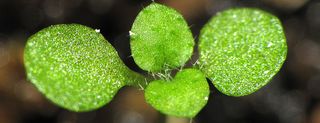New High-Tech Plants Could Detect Bombs or Chemical Weapons

Researchers have begun engineering plants to produce more loads of energy or sense pollution and even explosives.
In a new study, researchers embedded tiny structures called carbon nanotubes into the energy-making factories of plants, increasing their light-capturing ability by 30 percent. Using other carbon nanotubes, the researchers made plants sensitive to the atmospheric pollutant nitric oxide.
"Plants are very attractive as a technology platform," Michael Strano, leader of the study detailed March 16 in the journal Nature Materials, said in a statement. "They repair themselves, they're environmentally stable outside, they survive in harsh environments, and they provide their own power source and water distribution," said Strano, a chemical engineer at MIT.
Strano and his colleagues are pioneering a new field they call "plant nanobionics." "Nano" refers to the scale of the materials, which are on the order of one-billionth of a meter, and "bionic" refers to the use of nature to inspire engineering. [Top 10 Emerging Environmental Technologies]
Super-powered plants
The researchers were originally working on building self-repairing solar cells based on plant cells, which convert light into chemical energy, in the form of sugars and other compounds, by a process known as photosynthesis. The process relies on chloroplasts, the tiny energy factories inside plant cells.
Strano and his team wanted to isolate chloroplasts from plants and make them more efficient. But if chloroplasts are removed from plants, they start to degrade after a few hours due to light and oxygen damage.
Sign up for the Live Science daily newsletter now
Get the world’s most fascinating discoveries delivered straight to your inbox.
To protect chloroplasts against this damage, the researchers embedded the chloroplasts with tiny antioxidant particles, or nanoparticles, which scoop up oxygen radicals and other highly reactive molecules. In order to deliver the nanoparticles, the researchers coated them in a highly charged molecule that allowed the particles to penetrate the fatty membranes of the chloroplasts. As a result of the nanoparticles, the amount of damaging molecules plummeted.
Next, the researchers coated tiny cylinders called carbon nanotubes in negatively charged DNA and embedded them in the chloroplasts. The nanotubes worked like artificial antennae that allowed the plant to capture more light than usual.
The rate of photosynthesis in the chloroplasts with embedded nanotubes was almost 50 percent greater than in isolated chloroplasts that lacked the nanotubes. When the researchers embedded both antioxidant nanoparticles and carbon nanotubes in the chloroplasts, these cells continued to function outside of the plant for even longer.
The researchers also improved the energy efficiency of living plants. They infused nanoparticles into a small flowering plant called Arabidopsis thaliana, improving photosynthesis by 30 percent. What effect, if any, this has on the plant's sugar production is a mystery, the researchers said.
Pollution sensors
Strano and his colleagues also found a way to turn the Arabidopsis thaliana plants into chemical sensors, using carbon nanotubes that detect the pollutant nitric oxide, which is produced by combustion.
The researchers have previously developed carbon nanotubes that detect the explosive TNT and the nerve gas sarin, so they might be able to turn plants into sensors to detect these toxins at low concentrations. Nanobionic plants could also be used to monitor pesticides, fungal infections or bacterial toxins. In addition, the team is now working on incorporating electronic materials into plants.
Follow Tanya Lewis on Twitter and Google+. Follow us @livescience, Facebook & Google+. Original article on Live Science.

Most Popular

